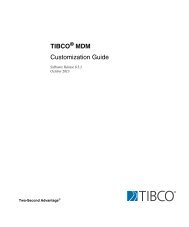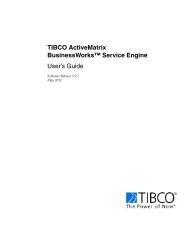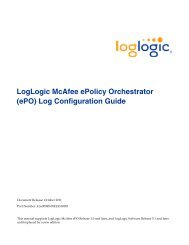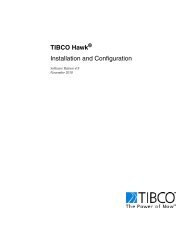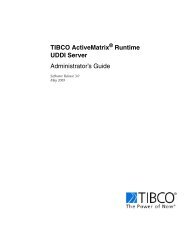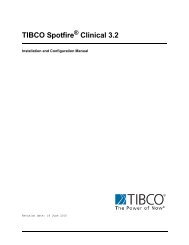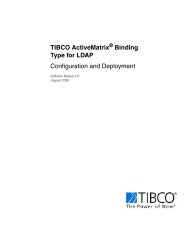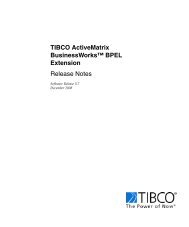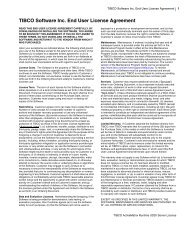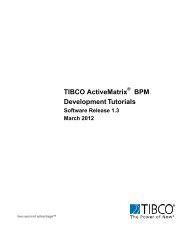TIBCO Spotfire Server 3.2.2 - TIBCO Product Documentation
TIBCO Spotfire Server 3.2.2 - TIBCO Product Documentation
TIBCO Spotfire Server 3.2.2 - TIBCO Product Documentation
Create successful ePaper yourself
Turn your PDF publications into a flip-book with our unique Google optimized e-Paper software.
Technical Reference<br />
Oracle (DataDirect Driver)<br />
tibcosoftwareinc.jdbc.oracle.OracleDriver<br />
Oracle (Native Driver, ojdbc6.jar)<br />
oracle.jdbc.OracleDriver<br />
Microsoft SQL <strong>Server</strong> (DataDirect Driver)<br />
tibcosoftwareinc.jdbc.sqlserver.SQL<strong>Server</strong>Driver<br />
Microsoft SQL <strong>Server</strong>(Native Driver, sqljdbc4.jar)<br />
com.microsoft.sqlserver.jdbc.SQL<strong>Server</strong>Driver<br />
jTDS (Native Driver, jtds.jar)<br />
net.sourceforge.jtds.jdbc.Driver<br />
Database Connection URL Components and Examples<br />
Component<br />
API<br />
Database Driver<br />
<strong>Server</strong> Type<br />
Hostname<br />
Port<br />
Database Name or SID<br />
Options<br />
Description<br />
Specifies which API to use. This is always jdbc.<br />
Specifies which database driver to use to connect to the<br />
database. Default tibcospotfireinc, which will use the<br />
<strong>Spotfire</strong> Datadirect driver. If you have installed a different<br />
driver, you may provide this here.<br />
Specifies the type of database server. Either sqlserver or<br />
oracle.<br />
Note: <strong>Server</strong> Type is only applicable when using the<br />
DataDirect driver.<br />
Specifies the hostname of the database server.<br />
Specifies the port which the database server listens to; for<br />
example 1433.<br />
Specifies the name (MSSQL) or SID (Oracle) that defines<br />
your <strong>Spotfire</strong> database.<br />
Specifies further options, separated with semicolons. Only<br />
necessary if you need to set something specific for your<br />
database server. This may include information such as a<br />
named Instance in an MSSQL server, for example. See<br />
example below.<br />
For the different supported database drivers this becomes:<br />
Oracle (DataDirect Driver)<br />
[API]:[DBDriver]:[<strong>Server</strong>Type]://[Hostname]:[Port];SID=[SID]<br />
140 (144) <strong>TIBCO</strong> <strong>Spotfire</strong>® <strong>Server</strong> <strong>3.2.2</strong>



